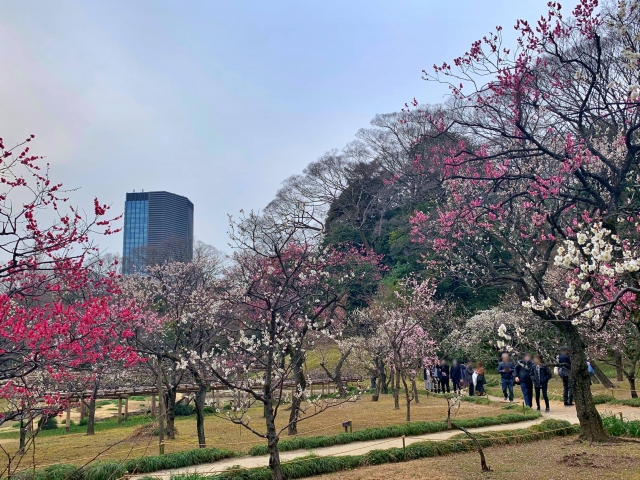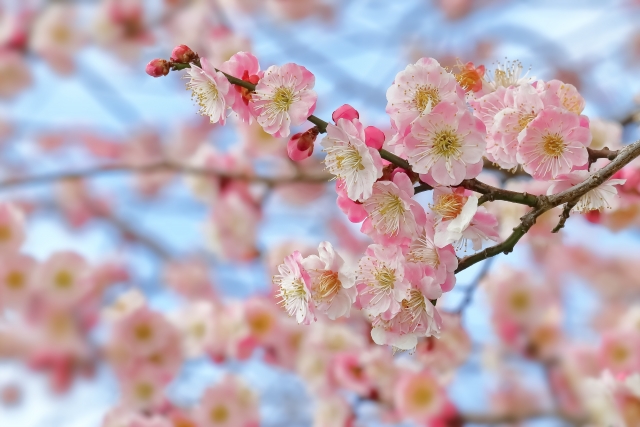These beloved blooms, known as “ume(梅)” in Japanese, typically flower from late January through March, offering visitors a spectacular preview of spring before the famous cherry blossoms arrive.
In this guide, we’ll explore the best times and locations to view plum blossoms across Japan, along with essential tips for making the most of your visit.
About Plum Blossoms
Plum blossoms hold a special place in Japanese culture, symbolizing perseverance and hope as they bloom during the final weeks of winter.
Unlike their more famous cousin, the cherry blossom, plum trees produce flowers with a subtle yet distinct fragrance that fills the air during the blooming season.
These blossoms are not only appreciated for their beauty but are also culturally significant, as the plum tree’s fruit is used to make umeboshi (pickled plums) and umeshu (plum wine), both essential elements of Japanese cuisine.
Difference plums and cherry blossoms
To help you distinguish between plum and cherry blossoms, here are the key differences:
| Feature | Plum Blossoms (Ume) | Cherry Blossoms (Sakura) |
|---|---|---|
| Blooming Time | Late January – March | Late March – Early May |
| Flower Shape | Round, dense petals | Slightly notched petals |
| Fragrance | Strong, sweet scent | Subtle to no fragrance |
| Branch Pattern | Flowers attach directly to branches | Flowers hang from stems |
Best Time to See Plum Blossoms
Timing is crucial for viewing plum blossoms at their peak.
Unlike cherry blossoms, which typically bloom for just one to two weeks, plum trees often flower for a longer period, giving visitors more flexibility in planning their visits.
The optimal viewing window varies by region and climate conditions, but generally, you can expect to see plum blossoms during these periods:
- Southern Japan: Late January to mid-February
- Tokyo/Kanto Region: Mid-February to mid-March
- Northern Japan: Late February to late March
Regional Blooming Schedule
For the most memorable plum blossom viewing experience, it’s essential to understand the regional differences in blooming times. Japan’s varied climate from south to north creates a progressive blooming pattern that you can follow throughout the season.
- January: Early blooms begin in Okinawa and southern Kyushu
- February: Peak season in most of western and central Japan, including Tokyo and Kyoto
- March: Late blooms in northern regions, particularly in Tohoku and Hokkaido
Weather Impact
Weather conditions play a crucial role in determining when plum blossoms reach their peak. Unlike cherry blossoms, plum trees are more resilient to cold temperatures and can withstand light snow, often creating spectacular winter scenes.
Several factors affect the blooming schedule:
- Temperature: Consistently warm days accelerate blooming
- Rainfall: Moderate rain helps buds develop, but heavy rain can damage full blooms
- Wind: Strong winds might cause early petal fall
Top Plum Blossom Viewing Spots
Japan offers numerous renowned locations for plum blossom viewing, each with its unique charm and historical significance. From sprawling plum groves to intimate temple gardens, these spots provide unforgettable experiences during the ume season.
Tokyo and Surrounding Areas

The Tokyo metropolitan area boasts several exceptional plum viewing destinations that are easily accessible by public transportation. These locations offer convenient options for both residents and visitors to experience the beauty of ume blossoms.
Must-visit locations in and around Tokyo:
- Hanegi Park (Setagaya): Home to about 650 plum trees and host of the popular Setagaya Ume Matsuri
- Yushima Tenjin Shrine: Famous for its historical connection to education and spectacular plum garden featuring over 300 trees
- Koishikawa Korakuen: One of Tokyo’s oldest gardens, offering stunning plum blossom views against traditional Japanese landscaping
Kyoto’s Historic Plum Gardens
Notable plum blossom spots in Kyoto:
- Kitano Tenmangu Shrine: Features approximately 2,000 plum trees of numerous varieties
- Jonangu Shrine: Known for its weeping plum trees and traditional garden setting
- Zuishin-in Temple: A hidden gem featuring both plum and cherry trees in a peaceful setting
Other Regions
Beyond Tokyo and Kyoto, Japan offers numerous other spectacular plum viewing destinations that shouldn’t be overlooked.
These locations often provide unique experiences with fewer crowds than their more famous counterparts.
Recommended spots across Japan:
- Kairakuen (Mito): One of Japan’s three great gardens, featuring over 3,000 plum trees
- Osaka Castle Park: Combining historical architecture with approximately 1,200 plum trees
- Dazaifu Tenmangu (Fukuoka): Famous for its 6,000 plum trees and historical significance
When planning your visit to any of these locations, consider checking their official websites or social media accounts for current blooming status updates.
Many popular spots provide regular updates during the blooming season to help visitors plan the perfect timing for their visit.
Don’t miss the chance to experience this magical season, when Japan’s landscapes are transformed by these delicate and resilient blooms.



comment